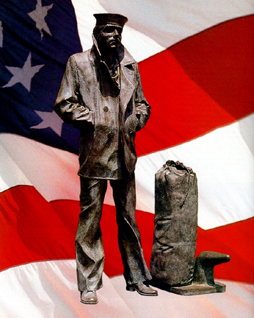WRIGHT-PAUL
PAUL RAYMOND WRIGHT

CWT

DIED ABOARD USS OKLAHOMA AT PEARL HARBOR
During World War II there were thousands of “ordinary” men who led otherwise quiet lives but who in a way seldom seen since that time, put their plans and dreams on hold, their lives in jeopardy, and turned out to squarely face a lethal foe, an assault on their values. The Log pages of the Navy Memorial name many of those valiant men about who little has been recorded. Many have been honored with the simple phrase – LOST AT SEA.
Chief Watertender Paul R. Wright was one of these valiant men. He died on what began as a quiet Sunday at Pearl Harbor, Hawaii, aboard USS OKLAHOMA. On the morning of December 7, 1941, OKLAHOMA was moored at Battleship Row adjacent to Ford Island in Pearl Harbor. The ship was berthed outboard of the USS MARYLAND (BB-46) and was a sitting duck when the Japanese struck the fleet in Pearl Harbor that fateful morning. An important inspection had been scheduled for OKLAHOMA the next day, so many of the ship’s watertight doors were open to allow easy access for the crew in preparing the ship for the scheduled inspection. As the Japanese began the attack OKLAHOMA became one of their first targets and within minutes three torpedoes exploded against her port side causing extensive damage below the waterline. As OKLAHOMA commenced to slowly roll over due to the tremendous amount of flooding seawater, terror reigned below deck and in the darkness men sought to find a way out of the burning, metal coffin. Barely ten minutes into the battle the 25-year old dreadnaught OKLAHOMA had been struck by nine torpedoes and finally rolled completely over until only her starboard propeller and some of her starboard underwater hull was visible. More than 400 sailors and marines who would never again see the light of day were trapped. OKLAHOMA suffered the second greatest number of casualties by any ship that day, surpassed only by the USS ARIZONA (BB-39) which had 1,177 officers and enlisted men killed.
As the Japanese attack began and battle stations sounded with the announcement, “THIS IS NOT A DRILL,” CWT Wright undoubtedly dashed to his duty station somewhere below deck. Little has been written concerning him in addition to his name appearing among the missing and presumed dead when the battle was over. However, records reveal that for his actions that day he was posthumously awarded the Navy and Marine Corps Medal. Although 32 crewmembers were subsequently successfully rescued alive from the capsized OKLAHOMA, CWT Wright was not one of them nor was his body ever identified. It must be presumed that his final resting place is the Memorial Cemetery of the Pacific in Honolulu where approximately 390 unidentified men from OKLAHOMA have been buried in common graves which have been simply marked, “UNIDENTIFIED – USS OKLAHOMA – PEARL HARBOR - DECEMBER 7, 1941.”
NAVY AND MARINE CORPS MEDAL CITATION
The President of the United States of America takes pride in presenting the Navy and Marine Corps Medal (Posthumously) to Chief Watertender Paul R. Wright, United States Navy, for distinguished heroism and intrepidity at the risk of life not involving conflict with an armed enemy, during the attack by enemy Japanese forces on the United States Pacific Fleet, Pearl Harbor, Territory of Hawaii, on 7 December 1941. When the Battleship USS OKLAHOMA (BB-37) capsized, Chief Watertender Wright, entrapped in one of the ship's compartments with a number of the crew, courageously risked his life in assisting fifteen of the crew to escape through a submerged porthole.
Submitted by CDR Roy A. Mosteller, USNR (Ret)

